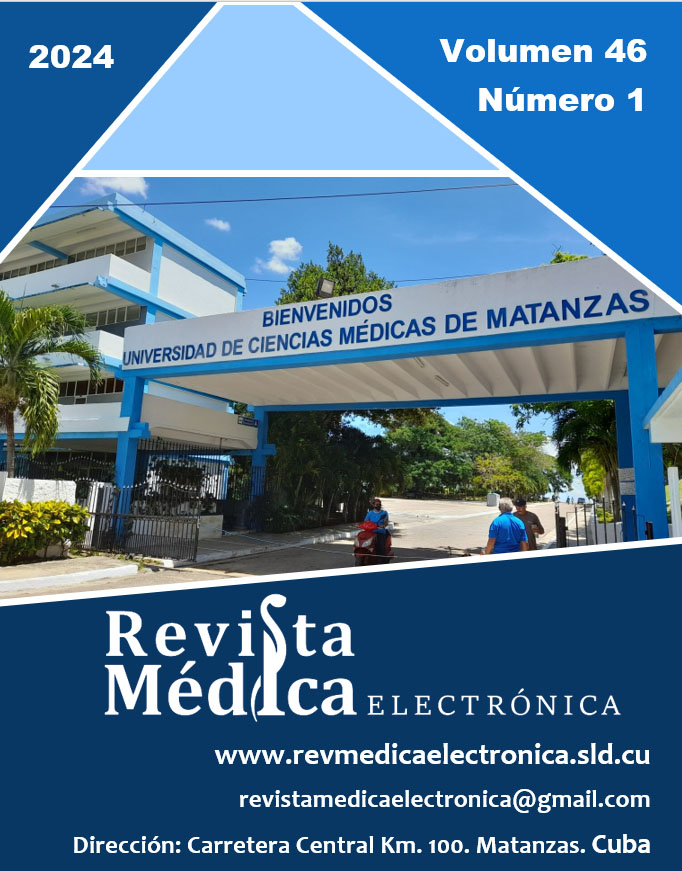Pharmacovigilance in the elderly in the postgraduate training of the family doctor
Keywords:
population ageing, elderly, pharmacovigilance, postgraduate training, family doctorAbstract
Introduction: Currently, population aging is one of the issues that draw the attention of Cuban society. People aged 60 and over are considered elderly; they need more medical attention and consume a high number of medications. For this reason, they are more exposed to adverse reactions. Pharmacovigilance is a relevant tool to ensure the quality, safety and effectiveness of medicines.
Objective: To characterize the current state of the subject pharmacovigilance in the elderly, in the curricular design of postgraduate training in the specialty of Comprehensive General Medicine
Methods: A cross-sectional study, in which the program of the Comprehensive General Medicine specialty was defined as the universe. The techniques used were review of programs and interviews with teaching vice directors.
Results: Pharmacovigilance in the elderly is not planned as content in the curricular design of the Comprehensive General Medicine residency program.
Conclusions: In the curricular design of the Comprehensive General Medicine residence program, the topic pharmacovigilance in the elderly is not raised, which constitutes an obstacle to achieve comprehensive training of excellence in professionals capable of prescribing medications effectively to a vulnerable population segment such as the elderly.
Downloads
References
2. Añorga Morales JJ. Lo increíble de los comportamientos humanos, la pedagogía, las ciencias de la educación y la Educación Avanzada. Rev Panor [Internet]. 2020 [citado 15/05/2023];15(2). Disponible en: https://revpanorama.sld.cu/index.php/panorama/article/view/1105
3. Cintra Cala D, Fernández Seco AE, coord. Envejecimiento saludable en Cuba [Internet]. La Habana: Editorial Ciencias Médicas; 2022 [citado 15/05/2023]. Disponible en: http://www.ecimed.sld.cu/2022/10/11/envejecimiento-saludable-en-cuba/
4. Organización de las Naciones Unidas. Decenio de las Naciones Unidas del Envejecimiento Saludable (2021-2030). A/RES/75/131 [Internet]. Nueva York: Asamblea General Naciones Unidas; 2020 [citado 15/05/2023]. Disponible en: https://documents.un.org/doc/undoc/gen/n20/363/91/pdf/n2036391.pdf
5. Keating NC, Rodríguez Mañas L, De Francisco A. Hacia el envejecimiento saludable en América Latina y el Caribe: ¿no dejar a nadie atrás? Rev Panam Salud Pública. 2021;45:e120. DOI: 10.26633/RPSP.2021.120.
6. Organización Panamericana de la Salud. El contexto sociodemográfico y económico del envejecimiento en América Latina. Washington, DC: OPS; 2023. DOI: 10.37774/9789275326831.
7. Dirección Nacional de Registros Médicos y Estadísticas de Salud. Anuario Estadístico de Salud 2022 [Internet]. La Habana: MINSAP; 2023 [citado 15/05/2023]. Disponible en: https://dpsalud.ch.gob.cu/2023/10/05/minsap-anuario-estadistico-de-salud-2022/
8. Plasencia-Castillo CI, Salvatierra-Hoyos BK, Velázquez-Guillén JM, et al. Polifarmacia y mortalidad en adultos mayores: El rol del sexo y la comorbilidad. Rev hab cienc méd [Internet]. 2022 [citado 15/05/2023];21(1). Disponible en: http://www.revhabanera.sld.cu/index.php/rhab/article/view/4147
9. Stable García Y, González Atá A, Cuba Venereo MM, et al. Aspectos de farmacovigilancia: adulto mayor y susceptibilidad de reacciones adversas a medicamentos. Rev CENIC Cienc Biol [Internet]. 2021 [citado 15/05/2023];52(2):187-200. Disponible en: http://scielo.sld.cu/scielo.php?pid=S2221-24502021000200187&script=sci_abstract&tlng=es
10. Organización Panamericana de la Salud. Farmacovigilancia [Internet]. Washington, DC: Organización Panamericana de la Salud; 2022 [citado 20/05/2023]. Disponible en: https://www.paho.org/es/temas/farmacovigilancia
11. Santos Muñoz L, García Millian AJ, Linares Morera A, et al. Reacciones adversas medicamentosas en ancianos. Matanzas 2014-2019. Horizonte sanitario [Internet]. 2023 [citado 20/05/2023];22(1):83-8. Disponible en: https://www.scielo.org.mx/scielo.php?script=sci_arttext&pid=S2007-74592023000100083&lang=pt
12. Ministerio de Salud Pública. Plan de estudios de la especialidad de Medicina General Integral. La Habana: Ministerio de Salud Pública; 2018.
13. American Geriatrics Society. American Geriatrics Society 2023 updated AGS Beers Criteria® for potentially inappropriate medication use in older adults. J Am Geriatr Soc. 2023;71(7):2052-81. DOI: 10.1111/jgs.18372.
14. Pastor Cano J, Aranda García A, Gascón Cánovas JJ, et al. Prescripción potencialmente inadecuada en mayores de 65 años según los criterios de Beers originales y su versión adaptada. Aten Primaria. 2018;50(2):106-13. DOI: 10.1016/j.aprim.2017.02.010.
15. Oropeza Pupo D, Baster Moro JC, Fernández Tablada ME, et al. Farmacovigilancia en el adulto mayor. Corr Cient Méd [Internet]. 2005 [citado 20/05/2023];9(2). Disponible en: http://www.cocmed.sld.cu/no92/n92rev2.htm
16. Jiménez-Pérez M, Caballero-Cruz G, Góngora-Valdés J, et al. Polifarmacia y adherencia farmacológica en adultos del Policlínico Docente “Louis Pasteur”. Universidad Médica Pinareña [Internet]. 2021 [citado 20/05/2023];17(2):1-9. Disponible en: https://www.medigraphic.com/cgi-bin/new/resumen.cgi?IDARTICULO=108745
17. Ramírez PA, Furones Mourelle J, Cedeño Ramos A. Deprescripción en el anciano polimedicado. Una mirada reflexiva en el contexto cubano. Rev hab cienc méd [Internet]. 2020 [citado 20/05/2023];19(3):e3416. Disponible en: https://revhabanera.sld.cu/index.php/rhab/article/view/3416/0
18. Ortega Suárez JD. El diseño curricular. Sus desafíos en la época actual de cambio de paradigmas científicos. Revista Cognosis [Internet]. 2020 [citado 20/05/2023];5(1). Disponible en: https://revistas.utm.edu.ec/index.php/Cognosis/article/view/2327
19. Mendoza Rodríguez H. Apuntes sobre Educación Médica [Internet]. La Habana: Editorial Ciencias Médicas; 2022 [citado 20/05/2023]. Disponible en: https://abacoenred.org/wp-content/uploads/2023/02/Apuntes-de-educacion-medica.pdf
Downloads
Published
How to Cite
Issue
Section
License
All content published in this journal is Open Access, distributed under the terms of the CC BY-NC 4.0 License.
It allows:
- Copy and redistribute published material in any medium or format.
- Adapt the content.
This will be done under the following terms:
- Attribute the authors' credits and indicate whether changes were made, in which case it must be in a reasonable way.
- Non-commercial use.
- Recognize the journal where it is published.
The copyrights of each article are maintained, without restrictions.






